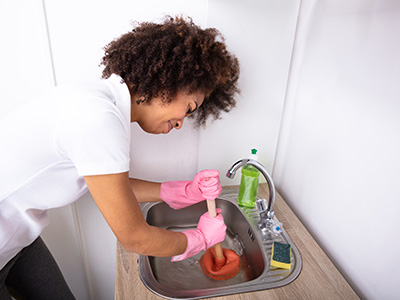
Clogged drains can be a nightmare, knowing how to both prevent your drain from clogging as well as learning how to unclog it if it does become clogged can save you from an expensive service call from a plumber.
Clogged drains are a common cause of household plumbing issues, especially during the summer months when we tend to shower more than usual. The primary culprit is often hair that ends up down the drains, but it is not the only cause. Knowing how to prevent clogged drains will help keep your homes plumbing system in good shape.
Prevention tips
The best way to keep your drains clear is to limit what is put into them
If you believe your drain may be clogged, you can try these tips before you call a plumber.
How to keep your drains clean
Clogged drains are a common cause of household plumbing issues, especially during the summer months when we tend to shower more than usual. The primary culprit is often hair that ends up down the drains, but it is not the only cause. Knowing how to prevent clogged drains will help keep your homes plumbing system in good shape.
Prevention tips
The best way to keep your drains clear is to limit what is put into them
- Keep food, coffee grounds and grease out of kitchen drains
- Pour liquid grease and waste oil into a sealable container, after is cools throw it into an outdoor bin or take it to a recycling centre
- Using a mesh screen or perforated shower drain hair catcher can avoid hair and soap scum building up in shower and bath drains
- Brush your hair before you take a bath or shower, this process will remove loose hair before you jump in.
- If you have a dog and wash it in your home bath or shower, we advise covering your drain with a washcloth, dogs can easily shed a lot of hair which will quickly build up in the drain
- Watch what you flush down your toilet. Toilets are designed for human waste and toilet paper. Flushing dense, stringy, or bulky items or materials can cause a clog
- Dental Floss, feminine hygiene products and other household waste should be disposed of in your bin, not your drains.
If you believe your drain may be clogged, you can try these tips before you call a plumber.
- Check the drain stopper, if you find hair or other debris, remove the drain stopper, clean it and reassemble it.
- Use a plunger. Cover the drain with the plunger bell so the edges seal, then push in and pull out, forcing water up and down the pipes. If the clog is in the sink, run at least two inches of water before using the plunger.
- Use a plumbing snake. If a drain is still clogged after you’ve tried a plunger, you’ll need to use a plumbing snake (also known as an auger). Push the snake down the drain, twisting as it moves around corners. The Corkscrew tip of the snake grabs hair and other blockages so you can pull them out.
- Get to know your P-trap. It is a U-shaped drainpipe under your bathroom and kitchen sinks, which you can unfasted to check for clogs or insert a plumbing snake. Place a bucket under the trap to collect any water or debris. The P-trap under your bath is not as easily accessible, so try plungeing or snaking through the bath drain first.
- For shower clogs a straightened wire coat hanger with a bent tip can easily grab any hair stuck in the drain. Use a plunger to remove the clog or bring it closer to the surface so you can reach it, If plunging doesn’t work try the snake.
How to keep your drains clean
- Clean your drains once a week. Pull out the stopper in your bathroom sink, remove any debris in the drain and rinse the stopper before reinserting it. Remove the drain stopper from your shower or tub drain and use a bent wire or hair-catching brush to remove hair and other debris.
- Flush your drains weekly. Fill your bath with hot water and then drain it. Run hot water down the shower drain at the end of each shower
- Deep clean your bath once a month. Remove the overflow plate and raise the pop-up assembly to reach the spring or rocker arm. Remove any hair or other debris and rinse the pop-up assembly well before replacing it.
- Use a bacterial drain cleaner once a month to maintain your drains. Unlike chemical drain cleaners, bacterial drain cleaners are biodegradable and non-corrosive, so they won’t damage your pipes. Preventing sink, bath and shower clogs before they occur is the best way to keep drains clear year-round. All it takes is some regular cleaning and a little maintenance.
